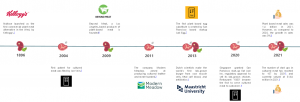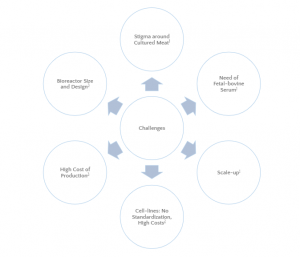Lab Grown Meat to Outgrow Plant Meat by 2040
According to the World Economic Forum, by 2040 Cultured Meat and Conventional Meat will be almost neck to neck with conventional meat catering to 40% of the demand and cultured meat to nearly 35%.
Even though plant-based meat has established a market for itself, how is it possible to claim that cultured meat will outgrow it! Before we answer that, let us look at the growth of plant-based meat and how the customer has reacted to the same.
The first Plant-based meat, Nuttose by Kellogg’s entered the market in the late 1890s. Since then plant meats have been consistently growing, it is reflected in the growing sales, start-ups active in the ecosystem like Beyond Meat and Impossible Foods, and more flexibility from customers to try it. That said, the heavy processing required to transform plants into meat and the high amount of additives used in the process, make them less appealing to the customers. Studies establishing that plant proteins are less readily absorbed by humans in comparison to conventional proteins further add to the problem. Source.
Hence, even though plant-based meats are well researched and commercialized, there is still a huge gap to bridge before they can mimic conventional meats. The French government’s recent ban on using terms like beef, steak, sausages, etc. on plant-based food products also highlights the hurdles that plant meat will have to overcome to replace conventional meat. Source.
However, one should not lose hope of moving to cleaner meat just because plant meats do not fulfill all the criteria. The industry does have a better alternative—cultured meat, also known as lab-grown meat. Lab meat was a little late in the whole race of meat alternatives. In fact, it was only in 2000, that the first patent on lab meat was filed. It took scientists over a decade since then to make the world’s first lab-grown meat burger. Source.
The research has accelerated at a much higher pace since then, and so has the number of start-ups operating in the cultured meat segment.

Through this article, we will investigate how cultured meat, despite the challenges, will take over plant meat. It is also important to note that plant meat will not just vanish in thin air and also develop a niche for itself in the industry.
Challenges of Plant-based Meat
There are several challenges associated with mimicking the characteristics of conventional meat in plant-based alternatives. The industry utilizes heavy processing and various additives to replicate the taste, nutrition, and texture (of conventional meat) in plant-based meats. Making them less healthy and hence less appealing to the customers.

Studies suggest that many customers do not derive the same joy from eating plant-based meat in comparison to conventional meats—owing to factors like taste and texture. Plus, there are challenges associated with nutrition profile, heavy processing, high salt content, and so on. Recently, France has also banned the use of terms like meat, beef, sausage, etc. on plant-based products.
If we look at it, in conjunction with cultured meat, which inherently mimics conventional meat, we believe that in the coming future cultured meat will take a lead over plant meat. That said, plant meat has already built a niche customer base for itself and it will continue to maintain the same.
Future of Non-Conventional Meat
In about two decades, cultured meat will outgrow plant-based meat, mainly due to consumer preference and reduced costs with more R&D. That said, customers, will keep consuming meat from all three streams—conventional (40%), cultured (35%), and plants (25%).
According to the World Economic Forum, “Cultured meat will outgrow novel meat replacements (i.e. vegan meats) sometime between 2025 and 2040 as both technology and consumer preferences develop.” Source. And, it seems highly probable, since the main challenge associated with cultured meat is not the taste or texture, but the costs.
The research has already started in this direction, with industry players and governments pumping in money to scale-up production and eventually bring down the costs of the final product. For instance, Aleph Farms, an Israeli cultured meat start-up, is gearing up for global commercialization by moving to a 65,000-square-foot production facility located in Israel.
Conclusion
On studying the domain in depth, our researchers found a boost in the Investments in the Cultured Meat Industry.
- As compared to 2020, the investment in 2021 has grown by 3.75 times. Celebrity investors such as Bill Gates and Leonardo Dicaprio are also investing in this space. Source
- The growth of the cultured meat industry is also evident from moves by giants such as Nestle which has plans to bring hybrid (plant and cultured meat) to the table.
- With only 5 companies in 2015, the number of start-ups in cultured meat reached 107 by 2021.
The growth is evident but the domain is relatively new which means a lot of questions can arise when entering the cultured meat market.
- What is the present scenario of Cultured Meat?
- What is the customer’s take on Cultured Meat?
- Which companies have already commercialized this alternative meat?
- Can you expect collaborations from the present players?
All these questions and your answers lie within our Detailed Research Report on Cultured Meat. This article is just the tip of the iceberg and to know in-depth about this promising domain, reach out to us by filling out the form below:
Author: Nidhi Balodi, Analytics Team.




